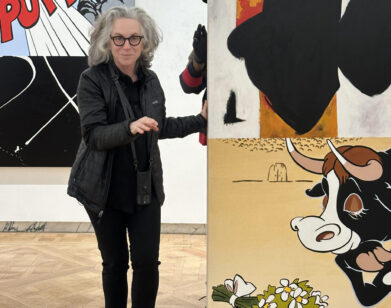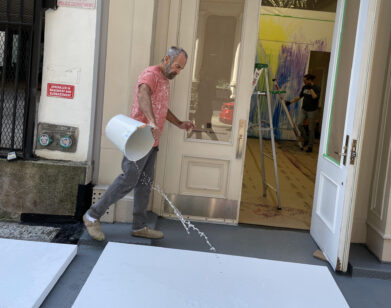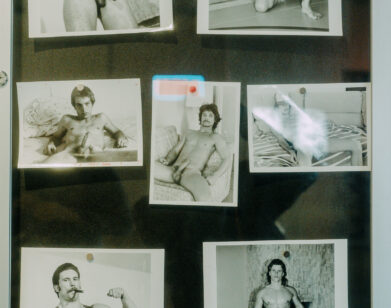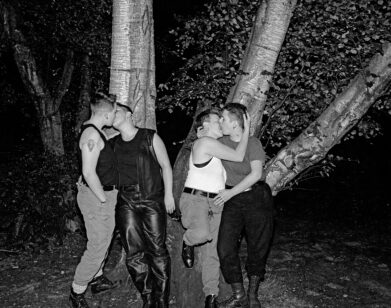Artist Andres Serrano gives us a tour of his bizarre religious memorabilia
This summer, during group shows and ahead of fall exhibition openings, we’re visiting New York-based artists in their studios.
Artist Andres Serrano turned 67 earlier this month, the same day Interview paid him a visit at his Union Square home and studio: a cavernous space filled with Renaissance paintings, rococo mirrors, and dozens of baroque Catholic artifacts—sculptures of Madonna and Jesus, a giant throne—which seemed to charge the air with sacrosanct energy. Serrano was raised in a Catholic home in Brooklyn, and religion—particularly the lush aesthetics of Catholicism—has found its way into much of his nearly 40-year body of work. In one of his earliest series, Immersions (1987-1990), he photographed various religious icons immersed in his own blood and urine. From this came Piss Christ (1987), a photo of a crucifix submerged in urine, which became his most recognizable work to date, not to mention his most controversial. The photo roiled viewers and members of Congress, outraged that he had received funding for it from the National Endowment for the Arts. It divided the nation over whether the government had the right to censor art. Despite the scandal, Serrano’s later work would go on to document no less provocative things—Ku Klux Klan members (The Klan, 1990); dead bodies (Morgue, 1992); sex (A History of Sex, 1995-1996); and excrement (Shit, 2007).
This fall, Serrano will show his most recent series, Torture, at Jack Shainman Gallery in New York. The four dozen photos—which first debuted in 2015, in France—explore the sweeping history of torture, from the medieval age to the present day. He will also show a new body of work in censor-happy China, possibly prompting a new wave of God-fearing over his provocatively delicious art.
MATT MULLEN: How long have you lived here?
ANDRES SERRANO: I’ve been here since 1999. I looked at more than 20 apartments before I got this one—it was the only one I actually felt connected to, and I wanted it right away. It’s about the sense of space, the big window and the fact that even though it’s a loft apartment, it doesn’t feel like a loft. Before that I was in Brooklyn; all my life I’ve lived between Brooklyn and Manhattan. When I was about 7 years old my family moved to Williamsburg, so I was one of the first artists in Williamsburg. [laughs]
MULLEN: Where does the Catholic iconography come from?
SERRANO: It’s all European and most of it comes from Christie’s or Sotheby’s, or other antique dealers here in New York and in Europe. I’ve been collecting it for at least 25 years. And what I collect is a certain period—17th century or earlier. There are Madonnas here from the 14th century, 13th century. The only thing that’s 18th or 19th century are the rococo mirrors.
MULLEN: Is it important to live in the same place that you make work?
SERRANO: Yes. Although I travel a lot, whenever I’m in New York I work here, unless I’m working on the streets—a few years ago I did a project called Residents of New York where I photographed people on the streets. I’ve only once had separation between home and studio, that’s when I had a space at PS1, in ’85, I think. Even though I shoot film, back in the old days I never needed a darkroom because I don’t print myself. I’ve never seen myself as a photographer, I’m an artist who happens to use a camera, so I never invested any time in wanting a real studio. There’s no sense in getting something you don’t need.
MULLEN: What is your pace of work like? Does it ebb and flow?
SERRANO: I tend to work in the summer more. As a kid, did you ever hear how when all of the other animals were fucking around in the summer, the squirrels were hiding their nuts? I feel like that. But beyond that, there’s always some kind of work to do. There’s going to the lab checking pictures, signing pictures, doing interviews. Sometimes an assignment might come by for the New York Times Magazine or New York Magazine. I shot Angora rabbits for the New York Times Magazine, and David Berkowitz, Son of Sam, for New York Magazine. They can count me on for rabbits or a serial killer, I don’t care.
MULLEN: How have you been spending your summer?
SERRANO: I had a trip to Beijing which happened about two weeks ago. It’s a new body of work that I’m doing for a museum called Red Brick. That’s going to open in November, and along with the new work that I’ve done for this show, there’s also a big selection of my own work, including Piss Christ. It will be interesting to show Piss Christ in China. I’ve never shown in China before. And it’s got the Morgue; it’s got Klan; it’s got a little bit of everything, so it’s a good way to test the waters. You know, China is the future.
MULLEN: And then at Jack Shainman Gallery this fall you’re showing Torture. I was revisiting those images and I realized torture never feels antiquated, it always manages to feel fresh and disturbing. Was that something you were trying to tap into when you were exploring this history?
SERRANO: When I make work, I don’t usually feel like I’m trying to tap into anything in particular, because I see myself as more of a classical artist, with connections to the past. So I try to make work that is timeless, as you say, like torture, racism, homelessness, religion, these things are all timeless and they keep cropping up in my work. And so I’m fixated on things not in the moment but of the times.
MULLEN: There was an element of performativity in this series, with you taking on the role of torturer, and your subjects the role of tortured. Is there always an element of performance in taking portraits?
SERRANO: With Torture, I felt like I had to take on the role of—or at least identify with—both the tortured and the torturer. So I had to think like the torturer, but also, in the course of doing the work, I felt like I was directing a movie. Because I had a team, I had people, models who were my actors, and I had a movie budget, so you know it felt like an unscripted movie that I was directing. And I didn’t know how it would all end until I put the pieces together and finished it. The History of Sex had a little bit of that, too, I had a crew, I had a team, I even had two different people filming me while I was doing my work, so it had those elements of movie making.
MULLEN: Has the reaction to Torture changed place to place by the viewing public or has it been consistent?
SERRANO: It’s been consistent in that it’s been positive. But it’s been mostly shown in Europe and now at the Station Museum in Houston. This show with Jack Shainman is my first in New York since I left Paula Cooper Gallery in 2008.
MULLEN: Why are Americans so squeamish about provocative imagery?
SERRANO: In America I’m primarily known as “controversial artist” Andres Serrano, the guy who did Piss Christ. In Europe you know they know me for a lot more. I’ve had about 22, 23 museum shows in Europe in the last 25 years, and by contrast I’ve only had one museum show in America, in 1995. This year I had a second museum show in America at Station, but that’s a private museum so in a way they can do what they want. I think in the States the problem is that museums don’t want to show me because I’m too controversial—whatever that means. This year I was appointed to the French Order of Arts and Letters, basically a knighthood. It just shows how in Europe they see me differently than in America.
MULLEN: You’ll always stay in America, right?
SERRANO: Well I’m a New Yorker so I can’t leave New York. And I still consider myself an American artist even though I travel a lot. So I represent what it means to be an American artist.
MULLEN: What does it mean to be an American artist?
SERRANO: You know, I tried to define my version of America in 2001 through 2004, when I did my America series. I did America because I felt we had been attacked as the enemy in September 11th, so I wanted to define who the enemy was. I did over 100 portraits, it took me three years to do the work, and I photographed people from all walks of life including some celebrities, like Donald Trump. At the time I ran into Nancy Spero and I said “Nancy, I’ve got a new show and it’s called America.” And Nancy laughed and said “Whose America?” And I said “Why, my America, of course!” We all have our own version of America. In a way, America is a state of mind. Everyone wants to claim it.
ANDRES SERRANO’S TORTURE SERIES OPENS SEPTEMBER 28, 2017 AND RUNS UNTIL NOVEMBER 4, 2017 AT JACK SHAINMAN GALLERY IN NEW YORK.






